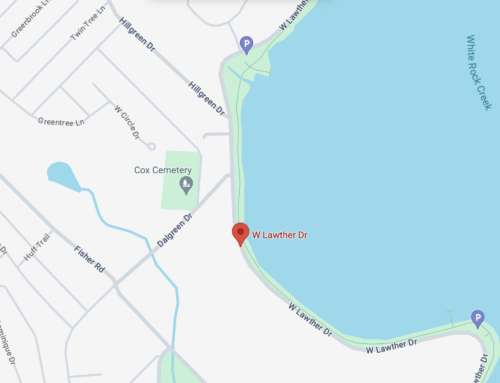Early plans for the Dallas Arboretum‘s parking garage on Garland Road meet the zoning requirements for the area, but that doesn’t mean neighbors are on board with the project.
The site in question (next door to Kwik Kar) is a paved lot that the Arboretum uses for employee and volunteer parking, and it’s zoned for a parking garage. With the capacity for about 1,200 cars, the structure will include two levels underground and four levels above ground.
As the height increases, the surface area decreases on the east side to minimize impact to the abutting residential street, Angora, in Forest Hills.
The building peaks at 34 feet, which is below the maximum height allowed by the Planned Development District. A 100-by-150-foot surface lot adjacent to the garage also will be used for parking.
All the Arboretum must do now is file an application with the city for a special-use permit to build an underground walkway linking the garage with the park. Garland Road is a state highway, and TXDOT has indicated support for the project.
“This is not a re-zoning in any sense of the word,” says Gloria Tarpley, the city plan commissioner for the district.
The architects unveiled conceptual designs at a well-attended meeting last night in Rosine Hall to which only three neighborhood associations were invited, although no one else was turned away.
Residents from those three areas, however, — Forest Hills, Little Forest Hills and Emerald Isle — didn’t let the Arboretum off that easy.

This early schematic design was shown to residents last night but may not represent the final result.
“Those schematic designs are just pretty pictures,” says Anita Childress, a lawyer in Forest Hills. She recently moved to the neighborhood after 16 years on Swiss Avenue and is no stranger to these kinds of issues. “The integration isn’t there yet,” she says, referring to the SPU needed for the underground walkway. “[This meeting] was limited in who could attend. They should have included Casa View and Peninsula … The Arboretum needs to be more engaged.”
Last year, about 1 million people visited the Arboretum. The new Children’s Garden, set to open this fall, has a capacity for about 1,500, turning over twice a day. Right now, there are 1,260 parking spaces throughout the grounds.
“We have a critical need for parking,” says John Armstrong, the Arboretum’s vice president of property development. “This handles the occasional surge so there’s not a chance that parking could bleed into the neighborhoods.”
The project will be privately funded, in part by using revenue from the paid parking garage to repay a private loan, and the estimated cost of the garage hasn’t been officially released.
Not everyone was critical of the Arboretum, including one attendee who expressed concern over the negativity toward what is supposed to be a wonderful neighborhood amenity. Others were more neutral, including Little Forest Hills co-president Max Davis, who volunteers regularly at the Arboretum.
“We’re not going to take a stand,” he says. “Our job is to communicate factual information to homeowners.”
He realizes the need for neighbors to be informed but also gives credit to the Arboretum for measures it already has taken to limit disturbance, such as “No Arboretum parking” yard signs.
But aside from possible noise, traffic and other negative impacts, some neighbors question how Arboretum parking on Garland will help the neighborhood, particularly when the garage sits empty during non-peak times.
One topic that kept coming up again and again: The vision for Garland Road. Maybe you recall the Advocate feature story about this way back in June 2010. The plan aimed to revitalize the area between East Grand and Interstate 635, creating a guideline for city planners. In addition to amenities like the Arboretum and White Rock Lake, the areas should provide other ways for residents and visitors to spend time in the neighborhood such as walkable retail and improved transportation.
So, how does the Arboretum garage fit into all of that? If there’s going to be a big building there on Garland, should it function as something more than just overflow parking?
“[The vision] did not have specific zoning restrictions,” says Gerald Worrall, the park board representative who served as the advisory committee chair. “It was more of a directional plan.”
Moreover, the possibility for retail components in the parking garage is simply out of the question, says Robert Reeves, the zoning consultant for the Arboretum.
“The PD flat-out doesn’t allow it,” he says.
The Garland Road vision focused more on decaying areas north of Peavy, and that stretch of Garland between Lakeland and Tavaros across from the Arboretum is just one small part of the corridor.
Still, neighbors are suspicious of the Arboretum’s continued expansion. It has purchased two lots on Garland between Lakeland and Tavaros and, according to a Dallas Morning News report last year, was in talks with other business owners, including Personal Touch Tree Service.
Last night, Armstrong said he knows nothing about plans to buy out Personal Care or any other prospective spots on Garland Road.
The Arboretum will file that SUP application “in the near future.” The project will go before the City Plan Commission and City Council during which residents will have opportunities to voice support or opposition. Another meeting — this time, public — will be scheduled sometime in August.
We’ll be tackling more unanswered questions about the project, including cost and possible property acquisitions, so check back for updates.






